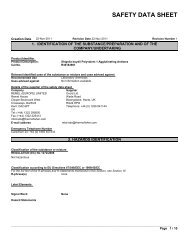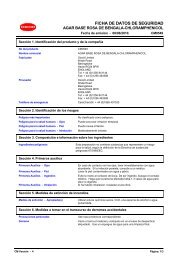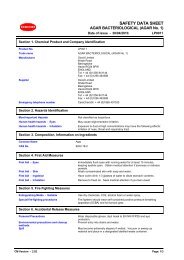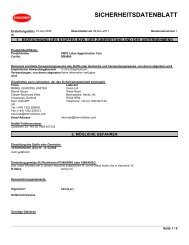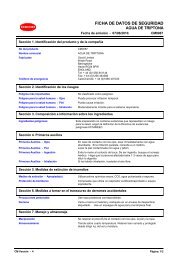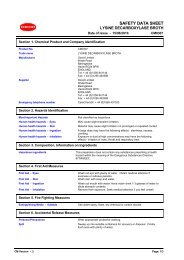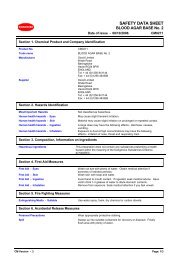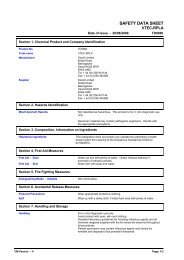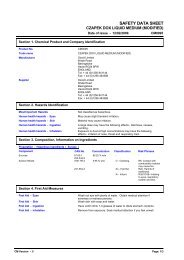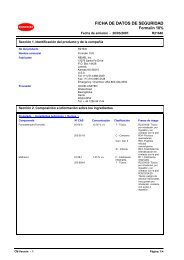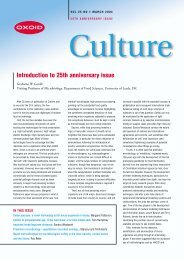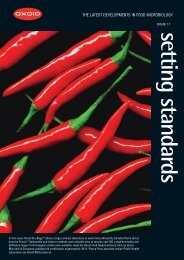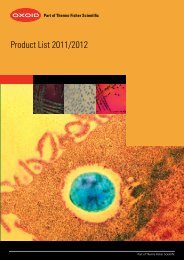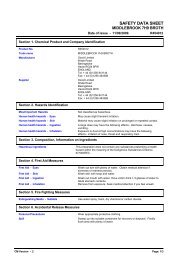AN MicroPlate - Oxoid
AN MicroPlate - Oxoid
AN MicroPlate - Oxoid
Create successful ePaper yourself
Turn your PDF publications into a flip-book with our unique Google optimized e-Paper software.
<strong>AN</strong> <strong>MicroPlate</strong> <br />
Anaerobe Identification Test Panel<br />
A1 A2 A3 A4 A5 A6 A7 A8 A9 A10 A11 A12<br />
N-Acetyl- N-Acetyl- N-Acetyl- Adonitol Amygdalin D-Arabitol Arbutin D-Cellobiose α-Cyclodextrin β-Cyclodextrin Dextrin<br />
Water D-Galactosamine D-Glucosamine D-Mannosamine<br />
B1 B2 B3 B4 B5 B6 B7 B8 B9 B10 B11 B12<br />
Dulcitol I-Erythritol D-Fructose L-Fucose D-Galactose D-Galacturonic Gentiobiose D-Gluconic D-Glucosaminic α-D-Glucose Glucose-1- Glucose-6-<br />
Acid Acid Acid Phosphate Phosphate<br />
C1 C2 C3 C4 C5 C6 C7 C8 C9 C10 C11 C12<br />
Glycerol D,L-α-Glycerol m-Inositol α-D-Lactose Lactulose Maltose Maltotriose D-Mannitol D-Mannose D-Melezitose D-Melibiose 3-Methyl-<br />
Phosphate D-Glucose<br />
D1 D2 D3 D4 D5 D6 D7 D8 D9 D10 D11 D12<br />
α-Methyl- β-Methyl- α-Methyl- β-Methyl- Palatinose D-Raffinose L-Rhamnose Salicin D-Sorbitol Stachyose Sucrose D-Trehalose<br />
D-Galactoside D-Galactoside D-Glucoside D-Glucoside<br />
E1 E2 E3 E4 E5 E6 E7 E8 E9 E10 E11 E12<br />
Turanose Acetic Acid Formic acid Fumaric Acid Glyoxylic Acid α- Hydroxy- β- Hydroxy- Itaconic Acid α-Ketobutyric α-Ketovaleric D,L-Lactic L-Lactic Acid<br />
butyric Acid butyric Acid Acid Acid Acid<br />
F1 F2 F3 F4 F5 F6 F7 F8 F9 F10 F11 F12<br />
D-Lactic Acid D-Malic Acid L-Malic Acid Propionic Acid Pyruvic Acid Pyruvic Acid D-Saccharic Succinamic Succinic Acid Succinic Acid M-Tartaric Acid Urocanic Acid<br />
Methyl Ester Methyl Ester Acid Acid Mono-Methyl<br />
Ester<br />
G1 G2 G3 G4 G5 G6 G7 G8 G9 G10 G11 G12<br />
Alaninamide L-Alanine L-Alanyl- L-Alanyl- L-Alanyl- L-Asparagine L-Glutamic Acid L-Glutamine Glycyl- Glycyl- Glycyl- Glycyl-<br />
L-Glutamine L-Histidine L-Threonine L-Aspartic Acid L-Glutamine L-Methionine L-Proline<br />
H1 H2 H3 H4 H5 H6 H7 H8 H9 H10 H11 H12<br />
L-Methionine L-Phenylalanine L-Serine L-Threonine L-Valine L-Valine plus 2'-Deoxy Inosine Thymidine Uridine Thymidine-5'- Uridine-5'-<br />
L-Aspartic Acid Adenosine Mono-phosphate Mono-phosphate<br />
INTRODUCTION<br />
The Biolog <strong>AN</strong> <strong>MicroPlate</strong> (Figure 1) is designed for<br />
identification of a very wide range of anaerobic bacteria,<br />
including the genera Bifidobacterium, Clostridium,<br />
Eubacterium, Fusobacterium, Lactobacillus, Lactococcus,<br />
Megasphaera, Pectinatus, Pediococcus, Peptostreptococcus,<br />
Propionibacterium and Weissella. These genera are important<br />
in industrial and environmental applications, especially the<br />
food industry where they are responsible for both food<br />
production and food spoilage. Some clinical species are not<br />
currently in our database. These will be added when they<br />
meet our performance criteria. The <strong>AN</strong> <strong>MicroPlate</strong> employs<br />
the same redox chemistry used in the Biolog GP2 and GN2<br />
<strong>MicroPlate</strong>s. This chemistry, based on reduction of<br />
tetrazolium, responds to the process of metabolism (oxidation<br />
of substrates) rather than to metabolic by-products (e.g. acid).<br />
Biolog’s universal chemistry works with any carbon source<br />
and greatly simplifies the testing process, as no color<br />
developing chemicals need to be added after incubation.<br />
<strong>AN</strong> MICROPLATE<br />
The Anaerobe Database contains over 350 taxa of anaerobic<br />
bacteria including over 70 species of lactic acid bacteria.<br />
FIGURE 1. Carbon Source in <strong>AN</strong> <strong>MicroPlate</strong><br />
The Biolog <strong>AN</strong> <strong>MicroPlate</strong> performs 95 discrete tests<br />
simultaneously and gives a characteristic reaction pattern<br />
called a “metabolic fingerprint”. These fingerprint reaction<br />
patterns provide a vast amount of information conveniently<br />
contained on a single Biolog <strong>MicroPlate</strong>. The patterns are<br />
compared using Biolog MicroLog database software to give<br />
an identification.<br />
Other anaerobic kit-based identification methods rely on fewer<br />
tests to perform identifications. Therefore an anaerobic<br />
organism that was previously characterized by another method<br />
may yield an identification result that differs from the Biolog<br />
<strong>AN</strong> <strong>MicroPlate</strong> & Database. This difference may be due to<br />
several factors. When determining the validity of an<br />
anaerobic identification result from the Biolog <strong>AN</strong> <strong>MicroPlate</strong><br />
and another method, consider the following:<br />
o The MicroLog System bases its identification on a<br />
larger number of tests<br />
o The MicroLog System covers more species<br />
o The taxonomy of many anaerobic genera is poorly<br />
defined



